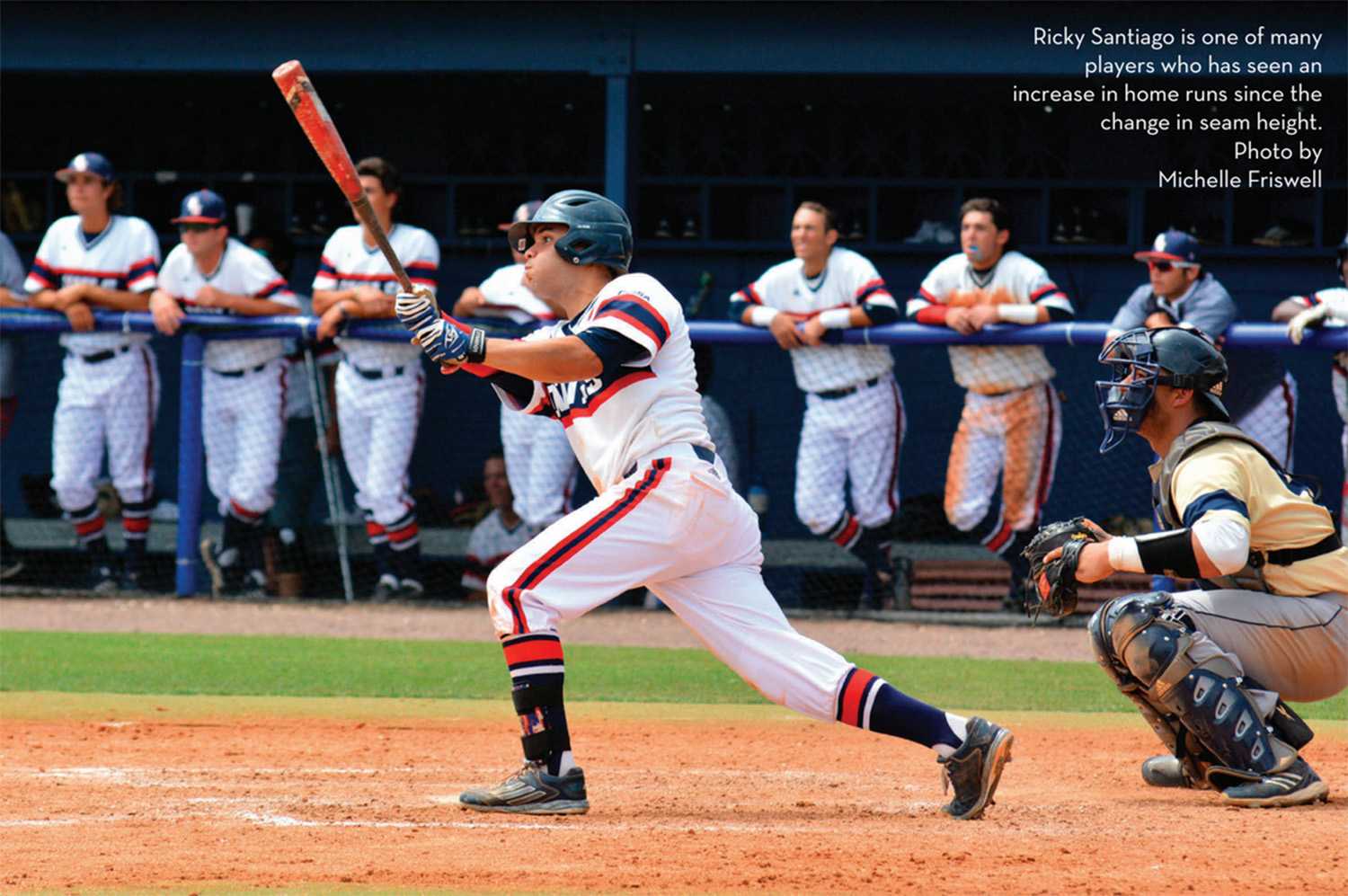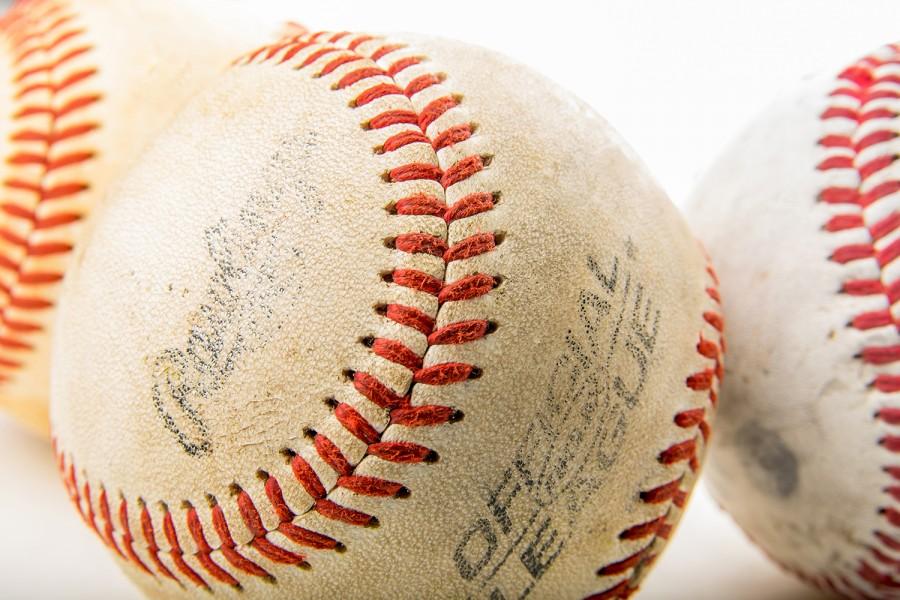Baseball change leads to more home runs
Home runs up 40 percent from last year due to lower seams on ball
Close – up of a lowered seam basebaled used by the NCAA starting this year. Mohammed F. Emran | Staff Photographer
May 1, 2015
They are white, round and leaving college baseball parks at a 40 percent higher rate than last season. No, it’s not the fans – it’s the baseballs.
The NCAA made a change in 2013 that just took effect for the 2015 season: to lower the seams on the regulation baseball from .048 to .031 inches, similar to the height of the seams in minor league baseball, but still higher than Major League Baseball. The UP reached out to Rawlings — the maker of both MLB and college baseballs — for the exact height of the major league ball, but received no comment on the size as of publication.
FAU baseball has definitely noticed the change in their own games. In 2014, the Owls hit 16 home runs for the whole season of 53 games. Through 37 games this current season, FAU has already surpassed that number, hitting 22 home runs in that span. Owl pitchers also have given up 19 home runs over that same time this season, compared to nine in all of 2014. Players and coaches are starting to take notice of the ball’s carry. “You know, it’s a funny thing that you can say ‘yes’ when you look at the numbers,” said head coach John McCormack. “But is that the baseball or the fact that everyone is a year older, a year stronger, a year wiser?”
The college ball is not exactly the same as the minor league ball, due to the difference in cores; the core of the minor league ball has a higher coefficient of restitution (average of speeds before and after collision) than the college ball, meaning that the pro ball is more lively when struck.
The change was made in an effort to raise offensive production in games, which had lowered since the introduction of BBCOR bats in 2011. Runs scored have also declined in recent years, decreasing from an average of 6.98 per game in 2010 to 5.08 in 2014.
BBCOR stands for batted ball coefficient of restitution, and was originally introduced to protect pitchers, who were facing batted balls upwards of 110 miles per hour from the BESR, or ball exit speed ratio, bats — the old standard. This was due to the “trampoline effect,” the force exerted on a baseball’s exit speed during contact.
The new bats, which are made of a blend of multiple metals instead of a single alloy, did lower the speed of baseballs that pitchers were facing, but at a cost of power from batters. In 2011— the first year after the change — the average amount of home runs per game dropped from .94 to .52, and continued to drop in the following seasons.
This past season, home run rates dropped to .39 per game, an all-time low since metal bats were introduced in the 1970s.
The lack of power was felt in the College World Series tournament as well. In 2010, the last tournament with the old bats, as well as the final tournament at Omaha’s Rosenblatt Stadium, teams hit a total of 32 home runs through the duration of the 16-game tournament.
Last season’s tournament was the fourth year where BBCOR bats were used, and was played at TD Ameritrade Park, which is in its fourth year of operation as Rosenblatt’s replacement. Hitters managed only three home runs over the 16 games. That’s a 29 home-run deficit that developed over that three-year span, a noticeable decline.
But that number is on the rise. Statistics gathered from the early season statistical trends show a 4.33 percent increase in runs scored, and a 7.38 percent raise in pitchers’ earned run averages from March 1, 2014 to March 1, 2015.

The science behind the change can help explain the rise in home run numbers. Tests performed at the NCAA bat lab at Washington State University on both balls revealed a “drag effect” present when both balls traveled a long distance. The test involved launching the baseballs from a machine at 95 mph with a 1,400 spin rate, and at an angle of 25 degrees to simulate the settings of a typical home run.Forces are acting on a ball from multiple directions when it is struck by the bat, including gravity and the speed of the ball going in the direction it has been struck.
Because we don’t live in a vacuum, wind also acts upon the ball as a force that works against its velocity.
The longer a ball travels, the more that the “drag effect” affects it. With the raised seams, balls traveled an average of 367 feet; the flat-seam balls traveled an average of 20 feet more. Lower seams protrude from the ball less, allowing for a smoother flight than the raised seams, which catch the wind slightly more.
The separation of 20 feet could mean the difference between a ball clearing a fence or simply bouncing off it. “The threat of the home run has crept —when I say crept, I mean crept — back into baseball,” McCormack said. “Six, seven years ago with the old bats and balls, the home run was always prevalent in lineups, [batters] one through nine.”
While skeptical that the ball is the full cause of the change, McCormack maintained it still affects the game. “I think that overall the difference is you see more balls getting into the gap, you see some balls getting over the fence, you see some balls getting through the 4-6 gap (area between the shortstop and second baseman) that you haven’t seen in the past couple of years.” “Yeah, I’m sure they have,” senior third baseman Ricky Santiago said about whether the balls had helped affect his home run total. Santiago is second on the team in home runs with four, behind junior left fielder Christian Dicks’ seven.

Last year, Santiago had three home runs in the 53 games he played in. “We started practicing with the balls in the fall, but once you’re in the game you don’t really think about it,” he added. “We use both the old and new balls in batting practice. If you hit a ball square on the barrel with the new ones, it definitely travels farther.” Senior pitcher John Sebelle prefers the new ball to the old one. “I like the shorter seams,” he said. “I feel like they don’t rip up your fingers as much. Personally, I like them because I have much more control than with the higher seams.They do go farther unfortunately, and hitters have more of an advantage than pitchers.”
Players who had moved to the professional ranks before the change noticed the difference between the pro and college ball as well. RJ Alvarez, who pitched for FAU from 2010-2012 and now pitches for Major League Baseball’s Oakland Athletics, noticed the switch when he started pitching in the minor leagues. “There was definitely a difference from the balls I used in college,” Alvarez said. “When I pitched there, the balls had huge seams.” Alvarez felt there was a definite adjustment process with throwing the professional baseballs.
“They definitely moved more when I threw in college than when I got to the minors and started throwing with the professional balls,” he said. “But when you get used to the ball with the lower seams, I feel it’s more comfortable to pitch with, and some say you throw a little harder with them.” It will take a few years to see whether the balls cause an increased number of home runs and runs scored over time, much like with the change of bats. But if the trends stay this way, it could be a dawn of new offensive spikes on college diamonds.








Jonathan Keohane • Oct 10, 2015 at 11:26 am
Question: In your test, was the spin on the balls you tested, the 1,400 rpm, topspin or backspin?